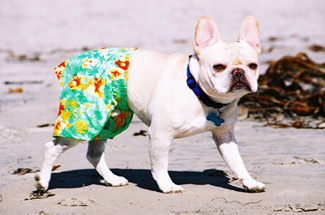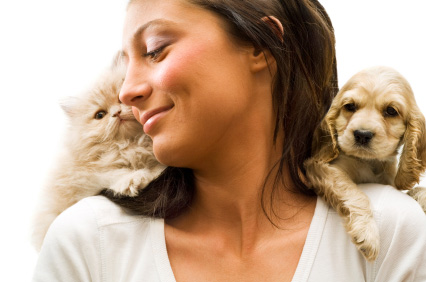 |
 |
|
 It seems that almost all pets have one thing in common: they
want to explore the world around them. Its not uncommon to hear pet owners talk
about their four-legged Houdini jumping fences or digging under them and
getting out. You might have invested some money in dog tags, but these can be a
hazard to your pet - getting caught or tangled and possibly choking them. Dog
tags also fall off fairly easily, and if your pet becomes lost, then likely it
will be turned in as a stray. Without identification, there is no way to
reconnect you with your beloved companion. It seems that almost all pets have one thing in common: they
want to explore the world around them. Its not uncommon to hear pet owners talk
about their four-legged Houdini jumping fences or digging under them and
getting out. You might have invested some money in dog tags, but these can be a
hazard to your pet - getting caught or tangled and possibly choking them. Dog
tags also fall off fairly easily, and if your pet becomes lost, then likely it
will be turned in as a stray. Without identification, there is no way to
reconnect you with your beloved companion.
Microchip pet identification is
used in cases where collars and ID tags have been lost.
Imbedding a microchip does not
involve surgery as it is injected into a thickly padded area between the
shoulder blades. A quick pinch is all your pet feels, and then it's smooth
sailing!
Microchips are easy to track. Each chip will have a
unique number, readable by a hand held scanner. The microchip company is then
called and the number is given to the
operator. The operator will look in their database for the owner's information,
so that you can be alerted as to your pet's location.
Microchips are affordable too! The insertion cost varies by
practitioner, with the average cost being $45. The microchip number then needs
to be registered with the microchip company, which shouldn't cost more than $25.
To get a more accurate estimate, contact your veterinarian.
|
|
 |
 |
|
 Gone are the days when you go on vacation and leave the
four-legged kids at home. Gone are the days when you go on vacation and leave the
four-legged kids at home.
Today, pet vacations offer pet menus, gourmet pet treats,
pet sitting, unique pet toys, complimentary pet bowls, and pet massages! No longer is there any
need to leave your fabulous feline or perky pooch behind. Some cruise lines
have Kennel Masters that oversee the various needs and desires of your furry
companion. Pet-friendly services and amenities include decadence for your pet,
like fresh-baked gourmet biscuits at turn down, comfortable beds and blankets, toys,
cat posts and scratchers, and a selection of premium pet foods.
Booking a hotel? There are lots of great resources for determining
what hotels within your price range will allow your pet to stay the night. Do
some research beforehand, so that your evening consists of comfortably
lounging with your pet, and not driving around to different hotels inquiring
about their pet services. The Internet is a great resource for finding pet friendly
hotels and hospitality services, and many offer memberships that include discounts.
If you are flying and want to take your pet with you,
contact the airline ahead of time to determine the cost and where your
pet can ride.
At times, there are restrictions on certain types of pets to reduce
your pet's risk of illness. If your pet is unable to accompany you in
the cabin, you might
consider the temperament of your companion before sticking them
plane-side.
Many pets experience a high amount of stress from this experience, and
it may
cause more problems than it's worth.
No matter where you take your pet, you should check in with their veterinarian
before you leave. Your pet might need extra vaccinations, or your vet might
have some good travel recommendations specific to your companion. Be sure to
take some items from home that your pet is comfortable with, and you should
have a memorable vacation.
|
|
 |
 |
|
 Some pets are downright finicky about everything: food, bed,
and even particular spots in the house where they elect to groom. They might be sweet to you, but you may be
surprised to uncover a streak of jealousy in them. Some pets are downright finicky about everything: food, bed,
and even particular spots in the house where they elect to groom. They might be sweet to you, but you may be
surprised to uncover a streak of jealousy in them.
It's not unusual for cats and dogs to express their anxieties over
a new person in the household by seeming to forget that they're
housetrained. Cats have a reputation for urinating on thier owner's
belongings, and dogs may find a new place to mark as their comfort
zone. This is not spiteful; rather it is a stress response and should
be treated by giving your pet more things to make them comfortable,
while firmly reinforcing the rules.
When people experiences issues with their dogs because of a
relationship, the troublemaker is often a dog who is accustomed to
being the center of attenion, constantly petted, and given frequent
treats. These dogs may act out when they are forced to share thier
human. They may jump inbetween their human and the new person or bark,
growl, and block the new partner from the bedroom.
Cats
may tend to hide when they don't like a person. They may run away, if
they are really put off by the new match, but this is unlikely if they
are given reassurances. Cats might snub the newcomer for some time, and
could act aggressively by hissing, spitting, and possibly clawing or
nipping.
If you find yourself in a standoff with your partner's pet, talk
to your partner and arrange to be the good guy for several weeks - maybe even a
few months. Deliver treats, favorite routines, feed the pet regularly if
living together, and take the animal for walks. If they are afraid and tempted
to run, try tossing some treats their way before you get too close.
|
|
 |
|
|
 |
|
|
|
 |
|
In This Issue:
|
|
 |
|
Contact Us
|

Name
Phone
Website
|

|
|
Giving your pet people food
|
|
For many types of foods, the line is blurry between what is
strictly for humans and what is acceptable to let your pets snack on. Many
people frequently slip their pets "people" food, while some only do it on
occasion, and some are staunchly opposed to doing so at all. If you do feel
like you want to give your pet a slice of what you're having, here are two things to
keep in mind:
Talk to your veterinarian before feeding your pet any human
food. Items like chocolate, raisins, and walnuts have been shown to have toxic
effects on animals. Consult with your veterinarian to be sure you avoid these
and other potentially harmful foods
Any change in diet can have an adverse effect on your pet.
What one pet may enjoy might cause digestive upset with another. Should your
pet experience vomiting, diarrhea or excessive flatulence after eating some
human food, discontinue feeding that. If symptoms persist, consult your
veterinarian.
Raw meats and eggs may have nutritional benefits; however,
there are serious food poisoning risks to be aware of. If you want to incorporate
these items into your pet's diet, address this with your veterinarian.
|

|
|
Claw-Trimming Basics
|
|
Trimming
your pet's nails can be a stressful experience for both you and your
pet. With some added assurance that you know what you are doing, your
pet will feel more at ease also.
For dogs or for cats, the first step in learning the proper
way to trim their claws is to consult with a veterinarian or professional pet
groomer. Ask them to walk you through this essential grooming technique.
If you attempt to trim claws without knowing what you are
doing, you could seriously harm your pet.
Claws are different than fingernails. When clipping claws, if you trim
too far down, you are hitting very sensitive nerve endings and might prevent your
pet from walking normally for a while, or could cause irrevocable nerve damage.
When trimming, look for the pink or dark area of the claw to
start. Move up from that some, as the area you want to trim is the
white, or
dead, part of the nail. Use pet-specific claw trimmers and don't apply
pressure until you've aligned the clippers properly. Then apply steady,
firm pressure in a fluid motion. Avoid jerky motions or going to slow.
One quick, smooth snip does the trick.
If you do clip too close, place a
tiny piece of paper towel tightly against the end of the nail and hold it for a
few minutes. The bleeding should stop within 5-7 minutes. You might also
try a special clotting powder for pets, which works immediately. If your
pet experiences difficulties after this, consult your veterinarian.
|
|
 |
